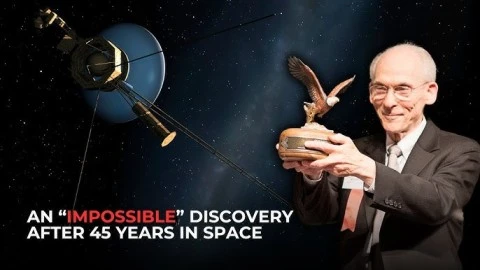What is Voyager 1 Impossible Discovery after 45 Years Nasa? For north of forty years, NASA's Explorer 1 shuttle has been a signal of human interest, wandering farther into the universe than some other man-made object.
Sent off in 1977, Explorer 1 has crossed the immense spread of our planetary group, sending back a mother lode of information that has changed how we might interpret the planets, moons, and the actual texture of room itself. In any case, lately, Explorer 1 has made a revelation that has left researchers both captivated and somewhat panicked.
What is Voyager 1 Impossible Discovery after 45 Years Nasa?

The Edge of Our Nearby Planet Group
In 2012, Explorer 1 crossed a limit known as the heliopause, denoting the edge of our nearby planet group's impact and the start of interstellar space.
This pivotal occasion was a victory for humankind, demonstrating that our innovative ability could come to the actual furthest reaches of our sunlight based area. Be that as it may, it was likewise a distinct sign of the immensity and obscure nature of the universe past.
A Frightening Disclosure
As Explorer 1 wandered further into interstellar space, it started to distinguish peculiar vacillations in the attractive field. These changes, while not expressly 'unnerving,' were not normal for anything researchers had seen previously. They proposed that the interstellar medium, the space between stars, was undeniably surprisingly tempestuous and dynamic.
Read Also: Why Is the Moon So Bright Tonight? What So Far
The revelation was disrupting in light of the fact that it tested our presumptions about the strength and consistency of the universe. It likewise brought up issues about the potential dangers that could lie on pause for future interstellar voyagers. To know What is Voyager 1 Impossible Discovery after 45 Years Nasa?
Suggestions for What's in store
Explorer 1's disclosure has significant ramifications for how we might interpret the universe and our place inside it. It proposes that the interstellar medium is certainly not a uninvolved void, yet a dynamic and possibly unfriendly climate. This raises worries about the attainability of interstellar travel, as well as the potential risks that would confront future wayfarers.
The disclosure has additionally prodded researchers to reexamine how we might interpret attractive fields and their part in the universe. It has prompted new investigation into the idea of interstellar space and the potential for life past our planetary group.
Looking Forward
Explorer 1 keeps on investigating the immeasurability of interstellar space, sending back information that is assisting us with figuring out the universe in new and astounding ways. While its disclosure has brought up some disrupting issues. What is Voyager 1 Impossible Discovery after 45 Years Nasa?

It has likewise opened up another part in our investigation of the universe. The excursion of Explorer 1 is a demonstration of the unfathomable interest and creativity of humankind. It is an update that we are still simply starting to start to expose the universe's secrets, and that there is still a lot to find out about the immense and steadily evolving universe.
As Explorer 1 proceeds with its excursion, we can barely comprehend what different disclosures anticipate. The fate of room investigation is loaded with guarantee, yet additionally full of difficulties. The excursion of Explorer 1 has shown us that the universe is a position of both miracle and risk, and that the mission for information is a continuous experience that will go on for a long time into the future.
What Powers the Voyager Spacecraft?
The greater part of the rocket hanging out in the nearby area depend on tremendous sun powered exhibits to get energy from the Sun. The Explorer make, nonetheless, were set out toward the divine 'burbs and couldn't rely upon sunlight based energy.
All things being equal, they were both furnished with a radioisotope thermoelectric generator (RTG). That is the thing Imprint Watney (Matt Damon) uncovered and used to warm up his meanderer in The Martian. That is not suggested except if and until you are abandoned alone on an abandoned planet.
Read Also: Lawrenceville Plasma Physics Inc: Pioneering New Frontiers
RTGs get energy from the compound deterioration of its radioactive fuel. Inside every one of the RTGs are pellets of plutonium-238. As the fuel rots, it discharges energy which strikes the inside and produces heat.
That intensity is then changed over into energy the shuttle can use to control its instruments. While this is more dependable than sun oriented energy in profound space, it has its own restrictions, to be specific a steady loss of control over the long haul.
How Long Will the Voyager Spacecraft Last?
Explorer had an arranged mission span of just five years, and it's extended that by almost a component of ten. Presently, almost 50 years after send off, they're as yet functional regardless dashing out of the nearby planet group at a pace of around 500 million kilometers (300 million miles) each year.
Taking everything into account, Explorer 1 and 2 would most likely joyfully keep working everlastingly, yet they'll ultimately run out of fuel. The plutonium inside their RTGs has a half-existence of around 88 years. You presumably recall from secondary school science class that half-life is the time it takes for half of any component to rot away.
FAQ's- What is Voyager 1 Impossible Discovery after 45 Years Nasa?
What did Voyager 1 discover after 45 years?
Explorer 1's revelation of the interstellar plasma wave has significant ramifications for how we might interpret the universe. It recommends that the interstellar medium is a more dynamic and complex climate than recently suspected.
Can we recover Voyager 1?
The fruitful recuperation of Explorer 1's frameworks not just takes into consideration proceeded with logical perceptions. It likewise gives significant experience to NASA engineers in keeping up with correspondence with far off shuttle — information that will demonstrate urgent for future profound space missions.
Will Explorer 1 actually take pictures?
On February 14, 1990, Explorer 1 took the first "family picture" of the Planetary group as seen from outside, which incorporates the picture of planet Earth known as Light Blue Dab. Before long thereafter, its cameras were deactivated to save energy and PC assets for other gear.
Will Explorer 1 leave our world?
One assessed timescale regarding the probability of the Trailblazer or Explorer shuttle slamming into a star (or heavenly remainder) is 1020 (100 quintillion) years. They are improbable, be that as it may, to acquire sufficient speed to get away from the Smooth Way cosmic system (or its future consolidation with the Andromeda world) into intergalactic space.
Where is Explorer now in 2024?
Starting around 2024, Explorer 2 is moving with a speed of 55,347 kilometers each hour (34,391 mph), or 15 km/s, comparative with the Sun, and is 20,439,100,000 kilometers (1.27003×1010 mi) from the Sun arriving at a distance of 136.627 AU (20.4 billion km; 12.7 billion mi) from Earth as of May 25, 2024.

